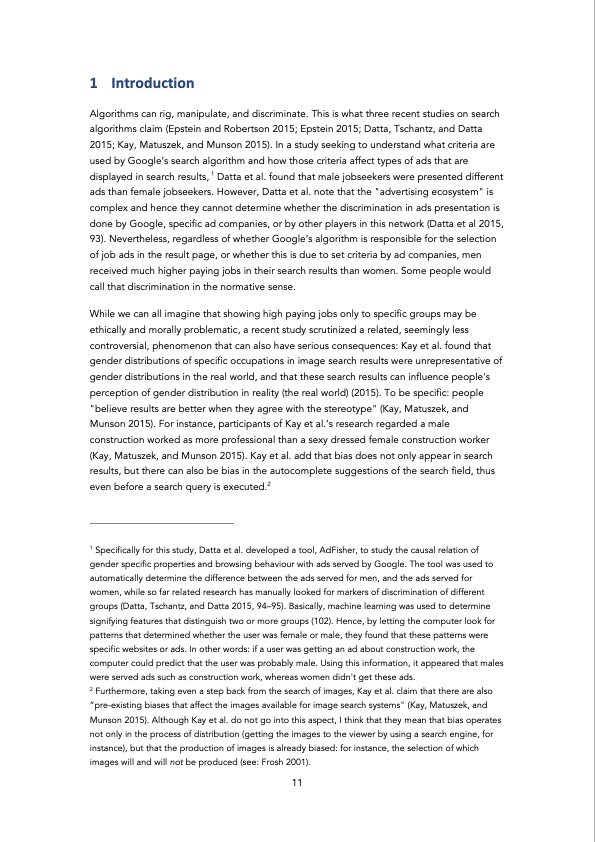
PDF Publication Title:
Text from PDF Page: 011
1 Introduction Algorithms can rig, manipulate, and discriminate. This is what three recent studies on search algorithms claim (Epstein and Robertson 2015; Epstein 2015; Datta, Tschantz, and Datta 2015; Kay, Matuszek, and Munson 2015). In a study seeking to understand what criteria are used by Google’s search algorithm and how those criteria affect types of ads that are displayed in search results, 1 Datta et al. found that male jobseekers were presented different ads than female jobseekers. However, Datta et al. note that the "advertising ecosystem" is complex and hence they cannot determine whether the discrimination in ads presentation is done by Google, specific ad companies, or by other players in this network (Datta et al 2015, 93). Nevertheless, regardless of whether Google’s algorithm is responsible for the selection of job ads in the result page, or whether this is due to set criteria by ad companies, men received much higher paying jobs in their search results than women. Some people would call that discrimination in the normative sense. While we can all imagine that showing high paying jobs only to specific groups may be ethically and morally problematic, a recent study scrutinized a related, seemingly less controversial, phenomenon that can also have serious consequences: Kay et al. found that gender distributions of specific occupations in image search results were unrepresentative of gender distributions in the real world, and that these search results can influence people's perception of gender distribution in reality (the real world) (2015). To be specific: people "believe results are better when they agree with the stereotype" (Kay, Matuszek, and Munson 2015). For instance, participants of Kay et al.’s research regarded a male construction worked as more professional than a sexy dressed female construction worker (Kay, Matuszek, and Munson 2015). Kay et al. add that bias does not only appear in search results, but there can also be bias in the autocomplete suggestions of the search field, thus even before a search query is executed.2 1 Specifically for this study, Datta et al. developed a tool, AdFisher, to study the causal relation of gender specific properties and browsing behaviour with ads served by Google. The tool was used to automatically determine the difference between the ads served for men, and the ads served for women, while so far related research has manually looked for markers of discrimination of different groups (Datta, Tschantz, and Datta 2015, 94–95). Basically, machine learning was used to determine signifying features that distinguish two or more groups (102). Hence, by letting the computer look for patterns that determined whether the user was female or male, they found that these patterns were specific websites or ads. In other words: if a user was getting an ad about construction work, the computer could predict that the user was probably male. Using this information, it appeared that males were served ads such as construction work, whereas women didn't get these ads. 2 Furthermore, taking even a step back from the search of images, Kay et al. claim that there are also “pre-existing biases that affect the images available for image search systems" (Kay, Matuszek, and Munson 2015). Although Kay et al. do not go into this aspect, I think that they mean that bias operates not only in the process of distribution (getting the images to the viewer by using a search engine, for instance), but that the production of images is already biased: for instance, the selection of which images will and will not be produced (see: Frosh 2001). 11PDF Image | peek into the discursive construction of the Google Search Algorithm: A critical discourse analysis

PDF Search Title:
peek into the discursive construction of the Google Search Algorithm: A critical discourse analysisOriginal File Name Searched:
thesis-google-search-algotithm.pdfDIY PDF Search: Google It | Yahoo | Bing
Cruise Ship Reviews | Luxury Resort | Jet | Yacht | and Travel Tech More Info
Cruising Review Topics and Articles More Info
Software based on Filemaker for the travel industry More Info
The Burgenstock Resort: Reviews on CruisingReview website... More Info
Resort Reviews: World Class resorts... More Info
The Riffelalp Resort: Reviews on CruisingReview website... More Info
| CONTACT TEL: 608-238-6001 Email: greg@cruisingreview.com | RSS | AMP |